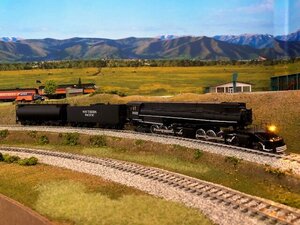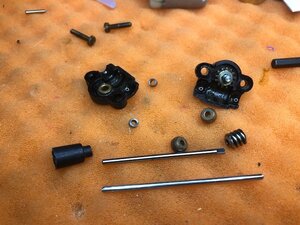You are using an out of date browser. It may not display this or other websites correctly.
You should upgrade or use an alternative browser.
You should upgrade or use an alternative browser.
Rivarossi 4-8-8-4 track radius capability?
- Thread starter Steam75
- Start date
Selector
Well-Known Member
You have the object in question. Please consider laying down temporary lengths of trackage, even on a countertop and a few sheets of cork or something, and conducting trials. There's no better data than that empirically derived. 
But, as a general rule, both for operational AND esthetic reasons, you should always place the widest curves possible in your space that still allows you to be happy with operations and the looks. You'll never be unhappy with wide(r) curves.
But, as a general rule, both for operational AND esthetic reasons, you should always place the widest curves possible in your space that still allows you to be happy with operations and the looks. You'll never be unhappy with wide(r) curves.
Thank you for your inputs.
This locomotive is in very good condition.
The box is AHM, described on a box end as "4-8-8-4 UP 'Big Boy', $59.98, #5114. (Made in Italy by Rivarossi)'
Underneath the rear bogies, stamped is a code, BRE/TATTO.
I wonder if that Id's the year of manufacture?
S75
This locomotive is in very good condition.
The box is AHM, described on a box end as "4-8-8-4 UP 'Big Boy', $59.98, #5114. (Made in Italy by Rivarossi)'
Underneath the rear bogies, stamped is a code, BRE/TATTO.
I wonder if that Id's the year of manufacture?
S75
It would be a late 1970’s vintage, and should be able to navigate tighter curves. That engine also has oversize flanges on the wheels, so make sure you use code 100 rail for your layout. Code 100 is what was standard for almost all flextrack, trainset track, and most add-on track until around the mid 1990s or so.Thank you for your inputs.
This locomotive is in very good condition.
The box is AHM, described on a box end as "4-8-8-4 UP 'Big Boy', $59.98, #5114. (Made in Italy by Rivarossi)'
Underneath the rear bogies, stamped is a code, BRE/TATTO.
I wonder if that Id's the year of manufacture?
S75
I have a early 70’s version of the Big Boy also imported by AHM and it will negotiate 18” curves if they are perfect. By that I mean the slightest kink or irregularity will cause the front bogies to derail. I have 18 and 24 inch radius curves on my layout and the 24’s work much better.
22' radius curves would be MUCH better.I have the subject HO Big Boy & not enough space currently to put down a test layout - I am wondering if the BB can safely navigate 18" radius curves whilst pulling a set of freight wagons, or should I stick to 22" radius curves in a design?
Thanks
S75
Don't know if an specifics here will help, but you might have a look
https://modelrailroadforums.com/for...or-long-freight-cars-steam-locos.30096/page-2
trailrider
Well-Known Member
Don't know if you can still find any, as Walthers appears to have discontinued Shinohara, but 20" radius sectional track is a great compromise between 18" and 22". Whatever you choose, stick with Code 100 due to the "pizza-cutter" flanges on the AHM/Rivarrosi wheels of that vintage.
GeeTee
Well-Known Member
To run steam ( 8 coupled) at less 26 " you need blind drivers , while the ones that have blind drivers may negotiate those turns , they don't do it very well. 2 wheel lead and trailing trucks can have issues . Any imperfection in the rail or the wheel flanges will cause derailments.
The wider the radius the better , less binding in the drive line , less forces in the drawbars and couplers , less binding between the flanges and the rail ,the more cars you can pull . You'll have far fewer issues at 26" and fewer still at 30" plus .
If I were starting a new layout and was going to run big steam and had a reasonable amount of space ( bigger than a 4X8) , I'd start with 36" radius min as my goal .
The wider the radius the better , less binding in the drive line , less forces in the drawbars and couplers , less binding between the flanges and the rail ,the more cars you can pull . You'll have far fewer issues at 26" and fewer still at 30" plus .
If I were starting a new layout and was going to run big steam and had a reasonable amount of space ( bigger than a 4X8) , I'd start with 36" radius min as my goal .
Selector
Well-Known Member
There should be a whack of empty space inside the tender if you are prepared to wire the decoder there and pass a tether or bundle forward to the locomotive. What will matter some is how to mount the decoder so that it won't rattle and possible damage itself, and so that solders and connections don't continually get flexed if the decoder is allowed to roam freely. What will count foremost is isolating the brushes on the motor from any possible contribution by the frame or wheels directly. In that respect, your BB should be a conversion like any other.
^^^ That, Ive done a lot of DCC Rivs and the best thing you can do it take out that old 3 pole motor. Its a power hog with really really bad slow speed capability. While your at it install a longer shaft in the first tower gear to give yourself more drive shaft to connectIsn't likely that the stock motor will draw too much current for most decoders?

 too.
too.Iron Horseman
Well-Known Member
Not a Big Boy but a couple 2-8-2's. I put the decoder and speaker in the tender. As always with pre-1990s stuff, the hard part is isolating the motor from the locomotive frame which is hot to the rail on one side. As I recall I had to craft a whole new motor mount. Might be different for the Big Boy. Looks like the MIkeMims has already solved that problem. I would also look into the Northwest Shortline re-gearing kit. Just so much smother than the stock worms esp with two of them. Also lots of wires between the loco and tender as I also use cams to synchronize the steam chuff.As an aside, has anyone fitted the subject pre 1975 Big Boy with a DCC decoder?

